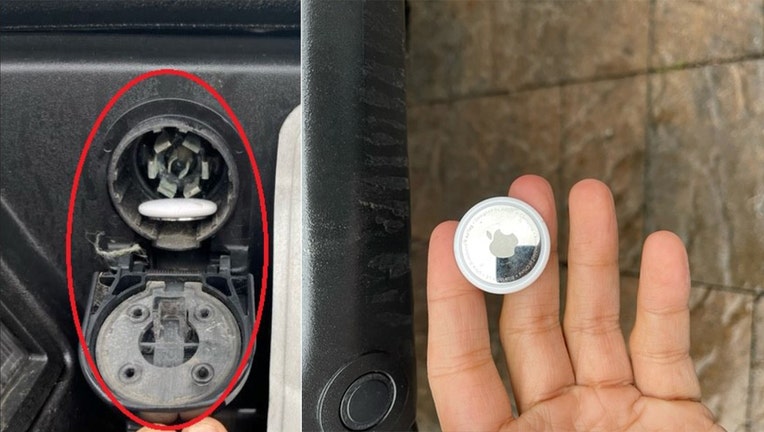Monday, December 13, 2021
Westjet Airlines Grants Holiday Wishes
Thursday, December 9, 2021
Humanoid Robot with Creepy Expressions

The UK robotics firm Engineered Arts has offered a sneak peek at its new humanoid robot ahead of a full reveal next year, and the preview is as incredible as it is unsettling. Ameca is presented as "the world's most advanced human-shaped robot," and a brief look at this "future face of robotics" suggests it might just live up to this claim. Engineering Arts is building Ameca to offer a platform for robotics technologies, looking to offer the ideal human-like vehicle for the development of human-like artificial intelligence. Its hardware and software are modular so customers will be able to secure just a head, or an arm, for example, depending on the application.
Part of the package is human-like facial expressions, which the firm hopes will enable Ameca to quickly build rapport with anyone, bridging the gap between humans and the digital world. The robot calls to mind Sophia, the humanoid robot granted citizenship rights to Saudi Arabia in 2017, who proceeded to answer questions from journalists in a press conference and later featured on The Tonight Show Starring Jimmy Fallon. The videos offering a first look at Ameca show the robot appearing to wake up, loosen its joints and look in amazement at the world around it. The expressions and gestures are incredibly natural and, at first glance, seem more lifelike than those of Sophia, though its worth nothing a 40-second preview is much different to a wide-ranging press conference or appearance on late night television.
Credits:
https://newatlas.com/robotics/ameca-humanoid-robot-video
Tuesday, December 7, 2021
Outages Brings Down Amazon Web Services
An Amazon Web Services outage is wreaking havoc on the e-commerce giant’s delivery operation, preventing drivers from getting routes or packages and shutting down communication between Amazon and the thousands of drivers it relies on, according to four people familiar with the situation. Three delivery service partners said an Amazon.com Inc. app used to communicate with delivery drivers is down. Vans that were supposed to be on the road delivering packages are sitting idle with no communication from the company, the person said.Amazon Flex drivers, independent delivery people who carry parcels in their own cars, can’t log into Amazon’s app to get assignments, said another person. The problems come amid Amazon’s critical holiday shopping season when the e-commerce giant can ill afford delays that could potentially create lasting log-jams.
AWS said it had identified the cause of “increased error rates” and is working to fix it. Meanwhile, the company is directing customers to alternative servers in its western region that aren’t experiencing problems. The increased errors are in the eastern North American region. Multiple Amazon cloud-computing services were affected, including Amazon DynamoDB and Amazon Elastic Compute. Video streaming service Netflix experiencd a 26% drop in traffic after the AWS problems were reported, showing how quickly outages can ripple outward, said Doug Madory, an analyst at the network monitoring firm Kentik in San Francisco.“It gets more and more complicated with software running these services, so when something goes sideways it can take a long time to figure out what went wrong and fix it,” he said. “Complexity has risks. You introduce unknown errors.”
Click here for the video
Credits:
https://abcnews.go.com/WNT/video/major-amazon-web-services-outage-affects-81609548
Monday, December 6, 2021
Car Thieves Use Air Tags to Track Vehicles
The police say that AirTags are being hidden in trailer hitches, bumpers, and other hard-to-spot places on vehicles. Because the AirTag was designed to be as unobtrusive as possible, there are plenty of hiding places for car thieves to place the device on an intended target. Stowing one of the trackers is quicker than actually stealing the car, and after the vehicle leaves the public parking lot, it's probably going to be kept somewhere private enough for the theft to occur. Apple previously updated the AirTag to reduce the length of time one of the trackers would need to be away from its owner before it started to alert people who have been traveling in close proximity to the device as a safeguard against the product being used to stalk someone. (Although that change only helps iPhone owners; Android users are left with third-party solutions while they wait for the company to deliver the app it promised to release on the platform.)
Credits:
https://www.pcmag.com/news/car-thieves-are-using-airtags-to-track-vehicles
Sunday, December 5, 2021
Hackers Attack Printer Receipts with Pro-Union Messages

Some users suggested that the messages were fake, but a cybersecurity firm that monitors the internet told Vice that they're legit. "Someone is... blast[ing] raw TCP data directly to printer services across the internet," GreyNoise founder Andrew Morris told Vice. "Basically to every single device that has port TCP 9100 open, and print[ing] a pre-written document that references /r/antiwork with some workers rights/counter capitalist messaging." The individual[s] behind the attack are using 25 separate servers, according to Morris, so blocking one IP won't necessarily stop the attacks. "A technical person is broadcasting print requests for a document containing workers rights messaging to all printers that are misconfigured to be exposed to the internet, and we've confirmed that it is printing successfully in some number of places," he said.
Credits:
https://www.engadget.com/someone-is-hacking-receipt-printers-with-pro-worker-messages-115040881.html
Tuesday, November 30, 2021
Drones to Help Re-seed Burned Forests

Last year's Castle Fire in California’s Sierra Nevada is estimated to have killed more than 10 percent of the world’s giant sequoias, the largest trees on earth. Sequoias can live through many fires over life spans that last thousands of years; their bark is fire-resistant and they rely on fire to reproduce. To help restore fire-ravaged forests and temper the effects of climate change, a handful of young companies want to scatter seeds from drones. At least three—Dendra Systems, CO2 Revolution, and Flash Forest—have pledged to plant a billion trees, or more. But it’s not clear how effective drone-led reforestation can be. One study found that fewer than 20 percent of seeds dropped by drone take root and grow into trees. None of the companies contacted by WIRED would disclose how many trees they’ve successfully grown to date.
After the Castle Fire, the California Department of Forestry and Fire Protection considered working with DroneSeed, a Seattle company that uses drones the size of washing machines to plant trees within six months of a fire, to help restore Mountain Home State Forest. DroneSeed is the only company in the US with FAA approval to fly multiple drones more than 55 pounds beyond line of sight, but the plan was put on hold. Not every drone-fired seed must take root for the method to be successful. According to Canadian startup Flash Forest, two drone pilots can scatter as many as 100,000 seeds a day. By comparison, a person working by hand can plant about 1,000 seedlings a day. In a landmark study released this summer, researchers from more than a dozen government agencies, universities, and companies in seven countries conclude that drone seeding has the potential to restore forests and cool the planet, but low seed survival rates and other challenges stand in the way.
Credits:
https://www.wired.com/story/drones-replant-forests-seeds-take-root/
Monday, November 29, 2021
CERN Detects Neutrinos for the First Time
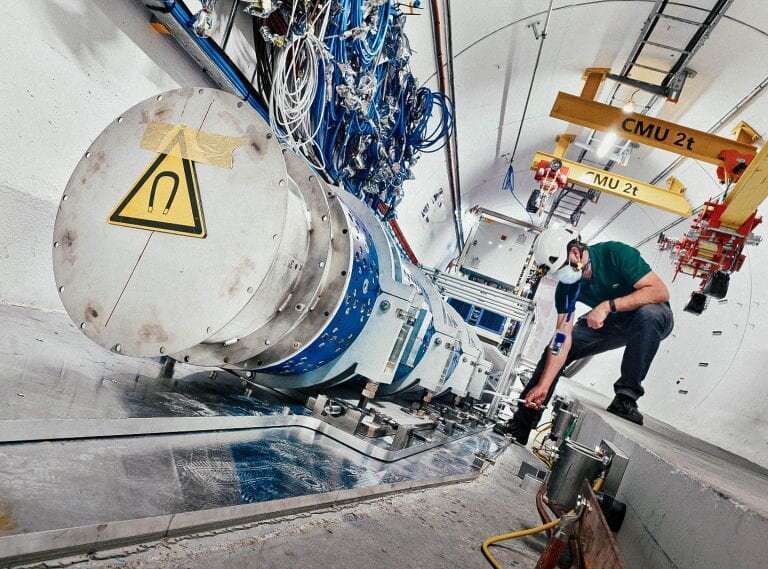
The particles were detected by a pilot run of an emulsion detector called FASER, a particle physics experiment at the Large Hadron Collider. Emulsion detectors are a way of looking for super-small particles, like the unknown stuff that constitutes dark matter. The FASER pilot detector was made of alternating lead and tungsten plates (101 and 120 of them, respectively), each containing a corresponding number of emulsion films. Neutrinos produced by the reactions in the Large Hadron Collider smash into the heavy metal nuclei in FASER, leaving marks of their presence on the emulsion layers.
Credits:
https://gizmodo.com/physicists-detect-neutrinos-for-first-time-ever-using-l-1848131886
S or N: $170 Squirt Gun

There are few ways to better spend a hot summer afternoon than with a water gun fight, and the creators of one the most advanced water blaster ever developed—one that shoots liquid bullets—is back with an upgraded version that’s quieter, faster, more powerful, and is less likely to leave the shooter soaking wet. If the last time you played with a water gun was when the Super Soaker reigned supreme, you’ll be surprised at how far they’ve advanced.
The Spyra One, which was realized through a Kickstarter campaign back in 2018 and then shipped a year later, features a rechargeable battery, a built-in pump that automatically sucks water out of a pool or a bucket for effortless refills, a unique firing mechanism that launches individual droplets of water with a satisfying amount of force, and even an LCD display counting down how many shots you have left. The Spyra One’s creators are promising the SpyraTwo is better in almost every way, with a range that goes about five feet further, faster refill times, and a battery life that promises twice as many shots before you need to plug the water gun in. (Yep, that’s one more device you’ll have to add to the nightly charging roster.) Most importantly, the SpyraTwo supposedly doesn’t drip anymore, which might be the biggest selling point.
Credits:
Thursday, November 18, 2021
Man make 1:10^100 Gear Reduction
Tuesday, November 16, 2021
S or N Purrible Helps Anxious Children Calm Down
Purrble is an interactive plush toy designed to help kids manage their emotions and feel calm. Purrble can be used in a variety of school-based settings: in the front office, in discipline-referral situations, one-on-one with counselors or behavioral aides, and in classrooms. This year, a limited number of Purrble calming toys are available to school-based staff across the United States so that we can learn how Purrble affects educators’ work with students. To ensure that a wide variety of schools and educators are included, we’re limiting Purrble purchases to 10 toys per school.
Monday, November 15, 2021
The Processor Turns 50 Years Old

In particular, the Intel 4004 is especially celebrated because it marked the beginning of Intel’s long and very successful microprocessor business, which dramatically shaped the evolution of the personal computer and still powers billions of computers today. Had Intel fizzled out as a company in the early 1970s, it’s very likely we might celebrate another company’s earliest chip as being just as important as the 4004. But, in hindsight, we can look back and see that the 4004 was the beginning of something very big.
Credits:
https://www.howtogeek.com/766783/the-microprocessor-is-50-celebrating-the-intel-4004/https://www.howtogeek.com/766783/the-microprocessor-is-50-celebrating-the-intel-4004
Sunday, November 14, 2021
Microsoft and Greek Government to Digitize Ancient Olympia

Microsoft's augmented reality smart glasses HoloLens use multiple sensors, advanced optics, and holograms, to display information, blend with the real world or simulate a virtual world. Among the 27 monuments to be preserved are the original Olympic Stadium, the temples of Zeus and Hera, and the workshop of the renowned sculptor Phidias. The buildings are as close as possible to their original forms and include historical timelines of the site's changes over time, and depictions of artefacts from each period. Through its AI for Cultural Heritage initiative, Microsoft partnered technology company Iconem, which specializes in digitising historic sites in 3D. Using on-the-ground cameras and drones to take hundreds of thousands of images of the site, Microsoft AI then processed the pictures to create models.
Credits:
https://www.bbc.com/news/technology-59219079
Thursday, November 11, 2021
Beijing to Use Robots to Monitor COVID
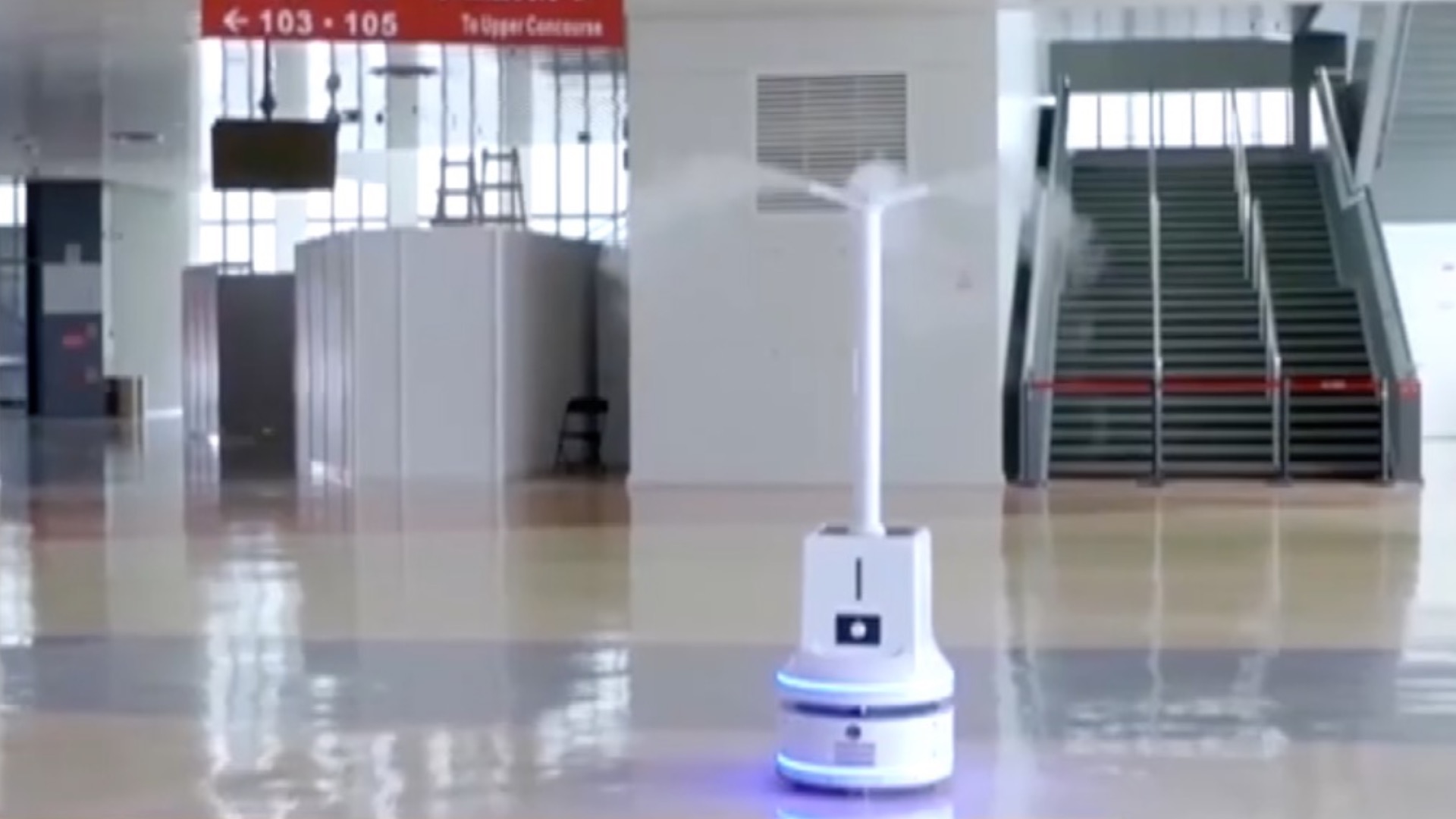
And another robot can undertake the work of three to four human volunteers. It can walk up to people who are not wearing masks and tell them to wear one and has a contactless hand disinfection device on its head. Wukesong Ice Sports Center will host the ice-hockey competition next February. Organizers are also testing a closed-loop system that separates athletes and staff members from the media and spectators. People inside the loop will sometimes need things like paper documents, personal gear and medical equipment. Robots will be utilized to get those things in without breaking the rules. The "delivery robots" will be on standby in the buffer zone. In this area, staff members can put objects on the robots, which can carry up to 300 kilograms. Once programmed for a certain destination, the robots can move freely within the loop until the mission is accomplished," said Zhang Fan, logistics manager of the sports center.
Credits:
https://news.cgtn.com/news/2021-11-09/Beijing-Winter-Olympics-Robots-help-protect-people-against-COVID-19-153mg04Z7PO/index.html
Monday, November 8, 2021
Something or Nothing: Rumba Lawn Mowers

The 435X is relentless. It mows rain or shine, night or day, whenever and however much you want it to mow. I played with this quite a bit, mowing all day every day versus mowing every few days and only a couple of hours. I did not keep precise track, but it seemed to cover the roughly one-acre of lawn it was tasked with in about six hours of mowing. The results for mowing daily were not noticeably different than mowing three days a week, so that's how often it ran for most of the time I had it. I ran it three days a week, six hours a day, to cover about an acre of lawn, and did not notice any impact on my electric bill no matter how frequently it mowed.
Credits:
https://www.wired.com/review/husqvarna-435x-awd-automower/
Sunday, November 7, 2021
What we all need: Noise Cancelling Forks
The result is what sounds like a flash of electronic dance music played through a smartphone application. This app takes its cues from highly directional microphones built into the fork, which send the slurping signals to the smartphone over NFC to trigger the noise-cancelling effect. Nissin has taken a crowdfunding style approach to selling the Otohiko fork. It says if 5,000 are pre-ordered at 14,800 JPY (US$130) a pop, it will actually start producing them.
Credits:
https://newatlas.com/noise-cancelling-ramen-fork/51873/
Thursday, November 4, 2021
NASA to "Nudge" an Astroid Away from Earth
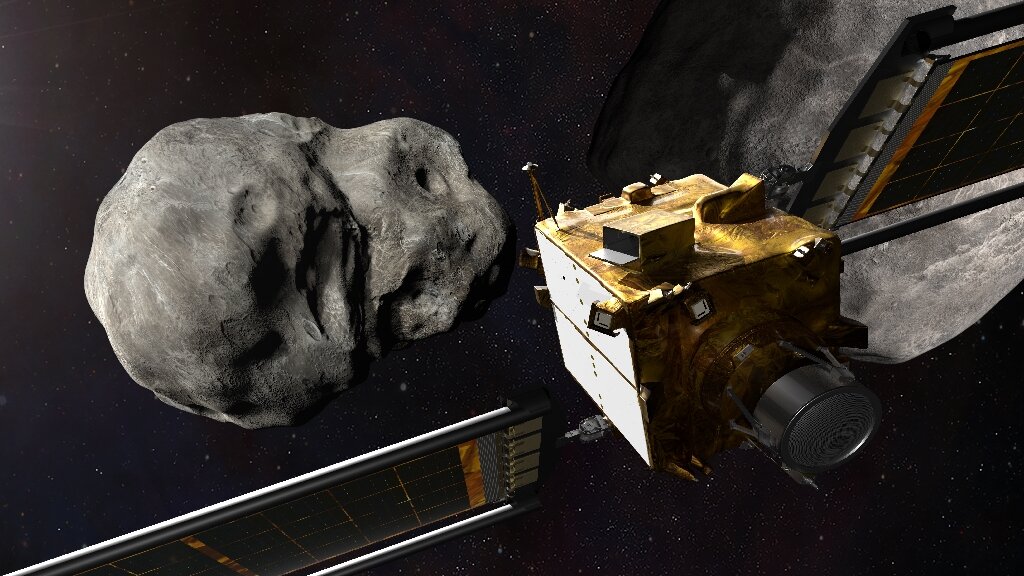
Nancy Chabot of the Johns Hopkins Applied Physics Laboratory, which built the DART spacecraft, said Dimorphos completes an orbit around Didymos every 11 hours and 55 minutes "just like clockwork." The DART spacecraft, which will weigh 1,210 pounds at the time of impact, will not "destroy" the asteroid, Chabot said. "It's just going to give it a small nudge," she said. "It's going to deflect its path around the larger asteroid. It's only going to be a change of about one percent in that orbital period," Chabot said, "so what was 11 hours and 55 minutes before might be like 11 hours and 45 minutes." The test is designed to help scientists understand how much momentum is needed to deflect an asteroid in the event one is headed towards Earth one day.
Credits:
https://phys.org/news/2021-11-nasa-deflect-asteroid-planetary-defense.html
Tuesday, November 2, 2021
ISS Enjoys Tacos with Peppers Grown in Space
The "pepper-picking day" for the first harvest took place on Oct. 29, according to the International Space Station Research Twitter feed, presumably a few hours before the taco feast. The crop came from the Planet Habitat-04 study, which is an ongoing series of trying to grow different plants in orbit. Previous harvests included space-grown Mizuna mustard, radishes, zinnias red lettuce and two other lettuce types. The latest crop of Hatch chile peppers arrived at the ISS June 5 with the SpaceX Dragon CRS-22 commercial resupply mission. NASA announced the peppers were growing in a July 13 statement. It was serendipity that the SpaceX Crew-2 astronauts, including McArthur, were still on board when the chile peppers were ready for harvest. Initially they were supposed to return home in late October, before the crops were ready. They're still in space awaiting the weather to improve for the launch of their relief mission, Crew-3.
Credits:
https://www.space.com/astronauts-eat-space-grown-chile-pepper-tacos
Sunday, October 31, 2021
JPL Knows How to Carve Pumpkins
Tuesday, October 26, 2021
Here are Sounds from Mars Captured by Perseverance Rover

Thanks to two microphones aboard NASA’s Perseverance rover, the mission has recorded nearly five hours of Martian wind gusts, rover wheels crunching over gravel, and motors whirring as the spacecraft moves its arm. These sounds allow scientists and engineers to experience the Red Planet in new ways – and everyone is invited to listen in. “It’s like you’re really standing there,” said Baptiste Chide, a planetary scientist who studies data from the microphones at L’Institut de Recherche en Astrophysique et Planétologie in France. “Martian sounds have strong bass vibrations, so when you put on headphones, you can really feel it. I think microphones will be an important asset to future Mars and solar system science.” Perseverance is the first spacecraft to record the sound of the Red Planet using dedicated microphones – both of which were commercially available, off-the-shelf devices. One rides on the side of the rover’s chassis. The second mic sits on Perseverance’s mast as a complement to the SuperCam laser instrument’s investigations of rocks and the atmosphere.
The body mic was provided by NASA’s Jet Propulsion Laboratory in Southern California, while the SuperCam instrument and its microphone were provided by the Los Alamos National Laboratory (LANL) in New Mexico. SuperCam studies rocks and soil by zapping them with a laser, then analyzing the resulting vapor with a camera. Because the laser pulses up to hundreds of times per target, opportunities to capture the sound of those zaps quickly add up: the microphone has already recorded more than 25,000 laser shots. Some of those recordings are teaching scientists about changes in the planet’s atmosphere. After all, sound travels through vibrations in the air. From its perch on Perseverance’s mast, the SuperCam mic is ideally located for monitoring “microturbulence” – minute shifts in the air – and complements the rover’s dedicated wind sensors, which are part of a suite of atmospheric tools called MEDA, short for the Mars Environmental Dynamics Analyzer. MEDA’s sensors sample the wind’s speed, pressure, and temperature one to two times per second for up to two hours at a time. SuperCam’s microphone, on the other hand, can provide similar information at a rate of 20,000 times per second over several minutes.
Credits:
https://www.nasa.gov/feature/jpl/hear-sounds-from-mars-captured-by-nasa-s-perseverance-rover
Monday, October 25, 2021
Blue Origin Announces Plans to Build a Space Station

First came the tourists. Next comes the business. Blue Origin says it will create a new privately owned space station in orbit around the Earth — what it calls a "mixed-use business park" in space. The company announced the plan months after completing its first human space flight on the New Shepard launch vehicle, an endeavor that included taking a paying customer into space. The new commercial space station will be called Orbital Reef, and Blue Origin — which is owned by billionaire Amazon founder Jeff Bezos — says that by the end of the 2020s, it will become "the premier mixed-use space station in low Earth orbit for commerce, research, and tourism."
Potential customers for the station range from space agencies and high-tech groups to countries that don't have their own space programs, as well as media and travel companies, the company says. Several companies are working with Blue Origin on the ambitious space station plan, including Sierra Space, maker of the reusable Dream Chaser spaceplane that is able to land at ordinary airports. Other partners include Boeing, Redwire Space, Genesis Engineering Solutions and Arizona State University. "Now, anyone can establish an address in orbit," Blue Origin said. "Orbital Reef expands access, lowers the cost, and provides everything needed to help you operate your business in space."
Credits:
https://www.npr.org/2021/10/25/1049077333/blue-origin-space-station-business-park-space-orbital-reef-bezos
Sunday, October 24, 2021
VR Gets FDA Approval to Help Children With Lazy Eye
:format(webp)/cdn.vox-cdn.com/uploads/chorus_image/image/70022561/easy_to_use.0.jpeg)
The Food and Drug Administration approved a virtual reality-based treatment for children with the visual disorder amblyopia, or lazy eye, the company behind the therapy announced today. Patients watch modified TV shows or movies through a virtual reality headset to improve their vision. “We’re proud to be part of the FDA’s groundbreaking decision today, to approve a first-of-its-kind digital therapeutic that allows patients to watch their favorite TV shows and movies to improve their vision,” Scott Xiao, chief executive officer of Luminopia, the company that developed the tool, said in a statement. Around 3 percent of children have amblyopia, which develops when the brain and eyes stop communicating properly. The brain favors one eye, which leads to vision problems in the other eye. It’s the leading cause of vision problems in children. It’s usually treated by blocking the stronger eye with a patch or blurring drops, forcing the brain to rely on the weaker eye.
Luminopia’s approach uses TV and movies to develop the weaker eye and train the eyes to work together. Patients watch the show or movie through a headset that shows the images to each eye separately. The images shown to the stronger eye have a lower contrast, and the images are presented with overlays that force the brain to use both eyes to see them properly. An example of the video modifications used in the treatment. Image: Ophthalmology, the journal of the American Academy of Ophthalmology. Kids using the therapy and wearing glasses had more improvement in their vision than a similar group of kids who did not use the therapy and just wore corrective glasses full time during a clinical trial of the technology. After 12 weeks watching the shows one hour per day, six days per week, 62 percent of kids using the treatment had a strong improvement in their vision. Only around a third of the kids in the comparison group had similar improvements over the course of the 12 weeks.
Credits:
https://www.entrepreneur.com/article/368943
Friday, October 22, 2021
Needle-Free Injections Developed in Netherlands

Researchers in the Netherlands are developing laser technology to enable "virtually painless" injections without needles in what they call a breakthrough that will ease fear and lower the threshold for vaccinations. The "Bubble Gun" uses a laser to push tiny droplets through the outer layer of the skin, said David Fernandez Rivas, a professor at Twente University and research affiliate at the Massachusetts Institute of Technology who founded the idea. The process is quicker than a mosquito bite and "should not cause pain" because nerve endings in the skin are not touched, he said, adding this would be studied further.
"Within a millisecond, the glass that contains the liquid is heated by a laser, a bubble is created in the liquid, pushing the liquid out at a velocity of at least 100 km per hour (60 mph)," he said during an interview at his lab. "That allows us to penetrate the skin without damage. We don't see any wound or entry point." Rivas expects the invention will not only help more people get vaccinated, but will also prevent the risk of contamination by dirty needles and reduce medical waste. Testing on tissue samples has successfully been carried out with a 1.5-million-euro ($1.73 million) European Union grant. An application for funding to begin human testing with volunteers is expected to be submitted this month, Rivas said. A new start-up company will collaborate with the pharmaceutical industry to test and market the "Bubble Gun" technology, he said.
Credits:
https://www.reuters.com/business/healthcare-pharmaceuticals/virtually-painless-needle-free-injections-developed-netherlands-2021-10-13/
Wednesday, October 20, 2021
Solar Windows Could Replace Solar Panels
.jpg)
Glass is ubiquitous in human existence. It uses up a lot of space, and that space has just become a lot more useful. New technology from a company called Ubiquitous Energy in California has developed what they call the “ClearView Power Window“. This window transforms ultraviolet and infrared light into energy, while keeping the window clear for visible light. The company has spent a long time getting this technology into production. The baseline tech was invented in 2010, and it’s taken this long to get it to market. The good news is that it looks like this will be well worth the wait. This is a pretty straightforward bit of physics. Visible light has little or no role in solar power generation. Ultraviolet and infrared are high-energy and longwave heat energy respectively.
The ramifications of the new technology, however, go a long way beyond the basics. The huge areas used by windows can now be translated into effective power sources. Imagine a gigantic picture window which is also powering your house. The ClearView Power Windows are about 2/3 as efficient as solar panels. Given the often enormous volume of space occupied by windows in modern design, however, that is still a huge amount of reception area. There is also a very elegant simplicity to this technology. The ClearView Power Windows are coated with an organic dye which does the job of managing the UV and infrared wavelengths. According to sources, these windows would cost approximately 20% more than an equivalent normal window. As a viable commercial market option, therefore, ClearView Power Windows look like a pretty good all-round bet.
Credits:
https://www.digitaljournal.com/tech-science/op-ed-plain-glass-as-a-solar-panel-its-here-it-works-and-its-incredibly-useful/article
Tuesday, October 19, 2021
China Tests Hypersonic Missile

China is shooting down a report claiming it successfully tested an advanced weapon known as a hypersonic missile. Beijing described the launch as a "routine" test of a reusable space vehicle, but Washington insiders say that if China really has successfully tested hypersonic missile technology, the U.S. is simply not ready to contend with the threat that poses. Hypersonic rockets travel at least five times the speed of sound, and they can fly much lower to the ground than conventional ballistic missiles. That makes them much harder to trace, and thus much harder to stop. The last time the world saw China's arsenal of hypersonic missiles was in 2019, as the Communist Party put its latest technology on display in a huge military parade through central Beijing's Tiananmen Square.
On Monday, Beijing responded to the newspaper report, with Foreign Ministry spokesman Zhao Lijian telling reporters it was "not a missile" but rather "a space vehicle" used in a "routine test" as China develops technology to lower the cost of future space travel. But China has continued to build-up its military capabilities. The country already boasts the world's largest standing military force, and it hasn't been shy about throwing that weight around — the record 149 military flight incursions into Taiwan's air defense zone this month being the most recent example. Only the top levels of China's leadership may know if the country really carried out a successful test flight of a hypersonic missile — or "space vehicle." The U.S. and Russia have also been testing their own hypersonics, but if the Financial Times report is accurate, that would imply that China has taken the lead in the hypersonic arms race.
Credits:
https://www.entrepreneur.com/article/368943
Monday, October 18, 2021
Sea Level Rise Doesn't Affect All Coast Lines the Same
Even 1.5 degrees Celsius of warming will expose more people around the world to disastrous flooding, but it’s considered a sort of best-case scenario for limiting the effects of climate change. The world, unfortunately, is still on track to reach close to 3 degrees of warming in just 79 years. The renderings don’t take into consideration how levees might be able to hold water back; the authors of the research write that city planners will need to “defend” against the encroaching waters. Check out some of the visualizations of what places around the world could look like in coming centuries if the world doesn’t act fast enough to combat climate change. It builds on research published today in the journal Environmental Research Letters. Climate Central collaborated with researchers from Princeton University, the Potsdam Institute for Climate Impact Research, and Columbia University.
Credits:
Friday, October 8, 2021
S or N: Amazon Developing a Smart Refrigerator
Amazon is apparently making a smart fridge, because why not? The tech giant's fingers are already in practically every other pot. An Insider report on Tuesday revealed Amazon has turned its invasive eye toward big cold boxes, developing a new fridge stocked full of cameras. Using technology employed in its cashierless Amazon Go stores, Amazon's smart fridge will be able to automatically scan its contents to see what's running or expiring and notify you. It will also be able to keep track of what's in your fridge and what you tend to buy, and predict what you want. Other features reportedly in the works include the ability to supply nutritional information, as well as recipe suggestions to help use up expiring ingredients. Whether any of these recipes will actually be any good is another question.
And, of course, the fridge will likely work with Amazon's shopping services such as Amazon Fresh and Whole Foods to make ordering grocery deliveries easier. Considering smart fridges that track your inventory are already very much a thing, the integration of Amazon's grocery shopping services will likely be a major selling point of its fridge. An Amazon product without Amazon shopping integration is no Amazon product at all. mazon is shopping around for a home appliance company to partner with for manufacturing, which makes sense considering refrigeration is a new arena for the company. This isn't the first time Amazon has ventured into the world of kitchen appliances, though. The company previously released an Alexa-enabled microwave in 2018, to mixed reception at best.

Credits:
https://mashable.com/article/amazon-smart-fridge-report
Wednesday, October 6, 2021
Apple Remembers Steve Jobs 10 Years After his Death
Apple paid tribute to its late co-founder Steve Jobs on the 10th anniversary of his death with a homepage takeover on Tuesday. The presentation includes a video that highlights his vision and showmanship, as well as a statement from his family. Jobs died on Oct. 5, 2011, at the age of 56, after a battle with pancreatic cancer. Since then, the iPhone, Mac and iPad have been vital in making Apple into one of the most valuable companies in the world. Apple included a statement from Jobs' family, talking about his legacy. "One of our greatest sources of consolation has been our association of Steve with beauty," his family's statement reads. "The sight of something beautiful -- a wooded hillside, a well‑made object -- recalls his spirit to us. Even in his years of suffering, he never lost his faith in the beauty of existence."
Michael Dell, founder and CEO of Dell Technologies, spoke to CNET about his work with Jobs. “You can’t be following the rules and making amazing things happen. Steve was certainly exceptional in that regard,” Dell says. Tim Cook, Jobs’ successor as CEO, shared his thoughts with Apple employees via a companywide memo, obtained by Bloomberg. “[Steve] challenged us to see the world not for what it was, but for what it could be,” Cook writes. “I feel so lucky that we spend our days creating wildly innovative tools that connect people, inspire them to think differently, and empower them to make their own dent in the universe, too.”
Credits:
https://www.theverge.com/platform/amp/2021/10/5/22710841/apple-steve-jobs-memorial-10-years?utm_campaign=theverge&utm_content=chorus&utm_medium=social&utm_source=twitter&__twitter_impression=trueC
Tuesday, October 5, 2021
Facebook, Instagram, and Whats App Down for Hours Yesterday

Just as Facebook’s Antigone Davis was live on CNBC defending the company over a whistleblower’s accusations and its handling of research data suggesting Instagram is harmful to teens, its entire network of services suddenly went offline. The outage started just before noon ET and took nearly six hours before it was resolved. This is the worst outage for Facebook since a 2019 incident took its site offline for more than 24 hours, as the downtime hit hardest on the small businesses and creators who rely on these services for their income.
Facebook said in a blog post Monday night that the six-hour outage that took it offline along with Instagram, Messenger, Whatsapp, and OculusVR was the result of a configuration change to its routers — not of a hack or attempt to get at user data. The explanation doesn’t give much in the way of detail, but it seems like Facebook’s machines weren’t able to talk to one another — Facebook says that “this disruption to network traffic had a cascading effect on the way our data centers communicate, bringing our services to a halt.” CEO Mark Zuckerberg posted an apology Monday evening, saying the platforms were coming back online. “Sorry for the disruption today — I know how much you rely on our services to stay connected with the people you care about.”
Credits:
https://www.theverge.com/2021/10/4/22708989/instagram-facebook-outage-messenger-whatsapp-error
Sunday, October 3, 2021
San Francisco Grants Cruise Permit to Drive Passengers without Drivers
:format(webp)/cdn.vox-cdn.com/uploads/chorus_image/image/69410779/1189070708.jpg.0.jpg)
Cruise, the self-driving car company affiliated with General Motors and Honda, is testing fully driverless cars, without a human safety driver behind the steering wheel, in San Francisco. The company is among the first to test its driverless vehicles in a dense, complex urban environment. To be sure, the vehicles are not completely alone in the wilderness. In a video released by the company, a Cruise employee is seen in the passenger seat while the car drives itself through the darkened streets of San Francisco. Cruise’s vehicles all have an emergency switch in the center channel near the gear shift in case something goes wrong, and they are also monitored remotely by Cruise employees. Asked whether remote operators are able to take control of the vehicle when needed, the company declined to answer.
This is the first time that Cruise has demonstrated its independent capabilities. Its main rival, Google spinoff Waymo, has been testing its fully driverless vehicles in Phoenix for over a year, and recently announced it would be making its independent taxi service available to more customers. Cruise doesn’t allow non-employees to ride in its vehicles. The company had planned to launch a commercial taxi service in 2019 but failed to do so, and it has yet to publicly commit to a new date. Last year, Cruise unveiled the Cruise Origin, a fully driverless prototype vehicle without a steering wheel, pedals, or any controls typically associated with human driving. The vehicle, which will go into production at GM’s Detroit-Hamtramck plant, is built to be shared by multiple passengers — though it remains to be seen how much appetite there is for shared vehicles in a post-COVID world. Cruise recently unveiled a new set of safety protocols intended to keep people socially distant during trips and the vehicle sanitized between fares.
Credits:
https://www.theverge.com/2020/12/9/22165597/cruise-driverless-test-san-francisco-self-driving-level-4
Wednesday, September 29, 2021
S or N? Amazon's New Personal Robot -- Astro

Amazon's next big leap in hardware: a personal robot. On Tuesday, Amazon announced Astro, a home robot the company says can help owners keep up with tasks such as home monitoring or keeping in touch with family and friends. "One of the things I love about working at Amazon is inventing the future, and I've spent a lot of time since that day on a team that's imagining how robots can help customers in new ways at home," said Charlie Tritschler, vice president of products at Amazon in a blog post. It's available by invite only for $999.99.
Astro takes advantage of both Alexa and Ring, its line of home security offerings. The robot can be set to autonomously roam around your home to check for safety. For example, if you worry about leaving a stove on, you can ask Astro to check. Users can also ask Astro for information similar to Alexa, and with a display serving as the robot's head, they can also watch movies and TV shows as well as accept video calls. Amazon says several features have been added to Astro for owners concerned with privacy, such as the ability to turn off microphones and cameras and the option to set out-of-bounds zones within your home. The arrival of Astro is just the beginning. More companies are exploring robotics, and not just for vacuuming. Earlier this year, during the Consumer Electronics Show, Samsung unveiled Handy, which can help owners around the house with tasks like unloading the dishwasher. Meanwhile, entrepreneur Elon Musk unveiled the Tesla Bot last month. The humanoid robot was designed to help with physical tasks that might be unsafe for humans.
Credits:
https://www.usatoday.com/story/tech/2021/09/28/astro-amazon-home-robot-price-how-to-buy/5901364001/
Tuesday, September 28, 2021
Something Crashed into Jupiter
On September 13, 2021, at roughly 6:39 PM EDT, amateur astronomers monitored and recorded a colossally bright flash of what seemed to be an impact on Jupiter. Harald Paleske of Germany was recording the shadow of Jupiter's moon, Io, as it passed in front of the planet. But other astronomers involved included José Luis of Brazil, Michel Jacquesson and Jean-Paul Arnould in France, Simone Gelelli of Italy, and Didier Walliang and Alexis Desmougin of the Société Lorraine d'Astronomie, also on France. Many also filmed the event, and suspect an impact on Jupiter.
Scientists are unsure how often Jupiter is impacted by something so massive or high-velocity that it generates an impact flash we can see from Earth, but the consensus is it's fairly often; between 20 and 60 times every year. If the Earth experienced significant impacts with the same frequency, its surface might look very different, and so would whatever survived. But luckily, Jupiter's unconscionably strong gravitational field is gigantic, and accelerates incoming meteorites to unkind speeds, multiplying the kinetic energy of the incoming bodies by several orders of magnitude, which is proportional to the level of energy released upon impact (think of how baseballs hurt more if they slam into you with greater speed).
Credits:
https://interestingengineering.com/something-enormous-just-slammed-into-jupiter
Monday, September 27, 2021
Microsoft to Make Computer Mouse from Ocean Plastic
:format(webp):no_upscale()/cdn.vox-cdn.com/uploads/chorus_asset/file/22869957/Ocean_Plastic_Mouse___Profile_2000.jpg)
Over the years, we’ve seen many remarkable mice from Microsoft, but the one it’s announcing today focuses on recycling and sustainability instead of innovative scroll wheel controls or high-precision DPI. The Ocean Plastic Mouse is notable because it has a shell made of 20 percent recycled ocean plastic and packaging that is 100 percent recyclable. An August 2020 pledge from Microsoft said it will pursue a goal of zero-waste operations by 2030 and put an end to the use of single-use plastics in packaging by 2025. The small box this mouse comes in, made of recyclable wood and sugarcane fibers, represents a step toward that future. Microsoft also mentions a free mail-in program so people can send their old mouse for recycling.
That plastic shell uses resin with recycled material “made from plastic waste that is recovered from oceans and waterways.” The plastic waste gets turned into pellets, and eventually, those are blended in with the other materials that make up the shell of this mouse. To create the resin used in the Ocean Plastic Mouse’s shell, Microsoft teamed up with Saudi Basic Industries Corporation (SABIC), which is a subsidiary of Saudi Aramco. Big Oil’s involvement in an “eco-friendly” product gives more than a whiff of greenwashing, but it’s surprising as the petrochemical industry responds to the EV shift by increasing its focus on plastics. The Ocean Plastic Mouse is available for preorder starting today at a price of $24.99, featuring Bluetooth Low Energy wireless and Swift Pair connection. Like all of the Surface hardware revealed during the event, it will be available starting on October 5th in the US.
:format(webp):no_upscale()/cdn.vox-cdn.com/uploads/chorus_asset/file/22869953/Ocean_Plastic_Mouse___Internals_800.jpg)
https://www.theverge.com/2021/9/22/22684591/microsoft-ocean-plastic-mouse-recycled-sustainability
Friday, September 24, 2021
Michigan to Test Electrified Roadway to Recharge EVs
It is said that The Michigan Department Of Transportation will release a Request for Proposal on Sept. 28 to design, fund, and create the Inductive Vehicle Charging Pilot along a one-mile stretch of state-operated roadway in Wayne, Oakland or Macomb counties. “At MDOT, we know the future of mobility involves connectivity, and this initiative dovetails nicely with our other successes linking vehicles and infrastructure through technology,” said MDOT Director Paul C. Ajegba. “This is a model we will build on across the state to further promote the governor’s broad and ambitious vision. We’re in the midst of the most significant shift in the automotive industry since the Model-T rolled off the assembly line more than a century ago, and Michigan is once setting the course manufacturing the vehicles of the future and deploying charging solutions that make EV adoption more widely available” said Trevor Pawl, Chief Mobility Officer with the Office of Future Mobility and Electrification.
Credits:
https://www.abc12.com/2021/09/21/gov-whitmer-launches-initiative-nation-leading-wireless-ev-charging-infrastructure-michigan/
Tuesday, September 21, 2021
Viper: The Moon Rover

The VIPER mission has been aimed at the Moon’s south pole since VIPERs inception in 2019, but exactly where the rover should land to do the best science was the topic of extended and meticulous research. While the region west of the Nobile Crater is mountainous, NASA determined it is accessible by the rover — and will also provide access to small craters of scientific interest nearby. VIPER team scientists have already planned the 10 to 15-mile route during the rover’s 100-day mission. This route includes stops for at least six sites of interest as well solar charging and warming pit stops — the floors of some craters in the region, cast in permanent shadow, can measure a chilling negative 414 degrees Fahrenheit. VIPER will hunt for sub-surface water using a Neutron Mass Spectrometer, and then drill up to three feet beneath the lunar regolith to take samples using its Regolith and Ice Drill for Exploring New Terrain, or TRIDENT.
Credits:
https://www.inverse.com/science/why-nasas-viper-mission-is-important-for-future-moon-landings
Robots Deliver Food to Hungry College Students
Starship Technologies is expanding its footprint, deploying dozens of its pint-sized six-wheeled delivery robots on college campuses this fall. Currently, the company operates on 20 college campuses in 15 states with a global fleet that totals 1,000 robots. This expansion would add 85 more robots to that fleet. Starship claims that it has facilitated over 1.5 million deliveries worldwide since its founding in 2014. The company has raised $102 million so far, including $17 million in fresh funding announced earlier this year.
Credits:
https://www.theverge.com/2021/8/10/22617175/starship-technologies-delivery-robots-college-campuses
Monday, September 20, 2021
Virtual panther at Carolina NFL game
:format(webp)/cdn.vox-cdn.com/uploads/chorus_image/image/69862139/Screen_Shot_2021_09_13_at_8.45.12_AM.0.png)
This tech isn’t baked into an app, meaning you won’t be pointing your phone’s camera in the stadium to get another angle on the panther if you’re attending a game. The animations are intended to air live. In Sunday’s case, the video was broadcast live on the big screens at the stadium, and shortly after that, the video was posted to social media. (One cool tidbit: in the video, you can see that the stadium screens have black screens with cat eyes. Those were applied to prevent a mirroring effect, a PR rep for The Famous Group said.) While only the one animation of the panther was shown on Sunday, Slusser and Davis said that other animations for the panther are in the works. One potential example? Appearing during a crucial third down to “hover over the opposing team and growl at them,” Davis said. The illusion in the viral video is clever, but it isn’t perfect. The cat definitely looks like a big CGI creature. And near the end of the video, when the panther roars from the top of the Jumbotron, you can see that its feet don’t exactly align with the architecture on which it’s standing. But the giant virtual panther is a fun look at one possible use of AR to add to the experience of watching a big sports event.
Credits: https://www.theverge.com/2021/9/15/22672199/carolina-panthers-mixed-augmented-reality-viral-virtual-mascot
Tuesday, September 14, 2021
Facebook / Instagram Execs Knew Negative Impact for Teans

The research report from 2019 stated, “We make body image issues worse for one in three teen girls.” Another read, “Teens blame Instagram for increases in the rate of anxiety and depression,” according to the Journal. Although Facebook has taken some steps to potentially reduce negative impacts for teens, such as removing counts of “likes,” the company has publicly downplayed Instagram’s impacts. The research from Facebook does indicate that not all teens experience harmful effects from using the app. For many, connecting with peers and expressing themselves outweighed potential “negative social comparison.” Sens. Richard Blumenthal, D-Conn., and Marsha Blackburn, R-Tenn., in August requested that Zuckerberg release Facebook’s internal research on mental health impacts on young people. Facebook sent the senators a six-page letter that did not include its own studies, the Journal noted.
Credits:
https://www.cnbc.com/2021/09/14/facebook-documents-show-how-toxic-instagram-is-for-teens-wsj.html
Monday, September 13, 2021
Hat Blows the Rain Away
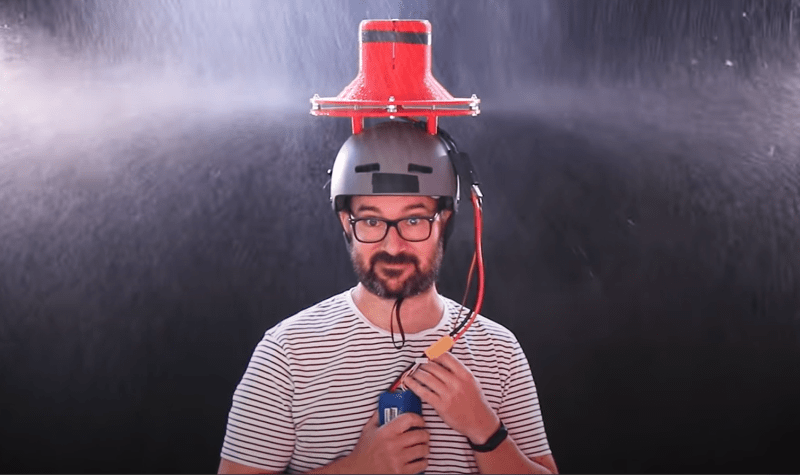
Not to be discouraged, he presses on regardless, substituting an electrical ducted fan (EDF), increasing the silliness-factor oh-so-little, after all as he says “I think I have a solution for all the issues — more power!” EDFs and other kinds of ducted fans are used in many applications nowadays. Thanks to advances in rare-earth magnets enabling more powerful brushless motors, combined with cheap and accessible control systems, there has never been a better time to drop an EDF into your latest madcap idea. We have covered many ducted fan projects over the years, including this great video about how ducted fans work, which we think is well worth a watch if you’ve not already done so.
Credits:
Texas Signs Social Media "Censorship" Bill

The new law would affect companies including Facebook, Twitter and YouTube. It's the latest Republican effort to take on the social media giants; Florida recently passed a law that would have prohibited social media platforms from banning political candidates, but a federal judge blocked the law before it was supposed to take effect. Some Republicans have for years claimed social media companies have an anti-conservative bias, complaints that grew after former President Trump was blocked from using Twitter and Facebook after his false claims about the 2020 presidential election led to the January 6 assault on the Capitol.
Credits:
https://www.cbsnews.com/news/texas-social-media-bill-signed-law-governor-abbott/
Friday, September 10, 2021
Somethin' or Nothin': Ray-Ban / Facebook Smart Glasses

With their core ability of taking photos and videos, Ray-Ban Stories are essentially a sleeker version of Snapchat’s Spectacles, which first debuted in 2016 to a lot of hype that quickly fizzled. These Ray-Bans don’t have displays in the lenses, like the latest Spectacles that were unveiled earlier this year. However, speakers on both sides of the frame can play sound from your phone over Bluetooth, allowing you to take a call or listen to a podcast without pulling your phone out. A touchpad built into the side of the frame lets you change the volume or play and pause what you’re hearing. Ray-Ban Stories are the first product in a multiyear partnership between Facebook and the European eyewear conglomerate EssilorLuxottica, Ray-Ban’s parent company. While they’re limited in what they can do, Ray-Ban Stories are the most normal-looking, accessible pair of smart glasses to hit the market so far. Both companies also see them as a step toward more advanced augmented reality glasses that overlay graphics onto the real world.
Credits:
https://www.theverge.com/2021/9/9/22662809/facebook-ray-ban-stories-camera-smart-glasses-hands-on
Tuesday, September 7, 2021
Howard University Cancels Classes After Ransomeware Attack

The university said it'll update faculty and students each day at 2 p.m. about whether campus operations will resume the next day. On Tuesday, Howard said the situation is still being investigated, and that, "there has been no evidence of personal information being accessed or exfiltrated; however, our investigation remains ongoing, and we continue to work toward clarifying the facts surrounding what happened and what information has been accessed." All online and hybrid undergraduate courses are still suspended for Wednesday, and only essential employees can access the physical campus. In-person undergraduate, graduate, professional and clinical experiential courses will resume.
Credits:
https://www.entrepreneur.com/article/368943
Monday, September 6, 2021
Ingenuity, the Mars Helicopter, Extends its Mission

Ingenuity is now being sent out to scout the way for Perseverance, using its high-resolution color camera. The purpose is twofold: to chart a path for the rover that is safe, but also which is of scientific interest, notably in geological terms. The helicopter should be able to keep operating for some time. But the approaching Martian winter will be challenging. NASA engineers, now armed with the data from Ingenuity's flights, are already working on its next-generation successors.
Credits:
https://www.sciencealert.com/remember-nasa-s-little-mars-copter-it-s-still-going-strong
Friday, September 3, 2021
Twitch Loses 25% Viewership After Streamers Boycott for a Day

#ADayOffTwitch came about because of growing frustration over Twitch’s unwillingness to crackdown more strictly on harassment and bigotry on the platform. In light of a growing number of hate raids targeting marginalized streamers and streamers of color in which bots spam channels with vitriol and slurs, content creators started putting together practical guides to help victims and calling on Twitch to overhaul the raid feature. #TwitchDoBetter, a hashtag created by streamer Rek It, Raven! built up steam throughout August around a 2018 tweet by Twitch telling people to hold it accountable. In light of the latest wave of criticism, the streaming platform rolled out improved chat filters and announced plans for a better ban evasion detection system sometime in the future. But streamers want swifter, more decisive action, which culminated in plans for a September 1 boycott.
Credits:
https://kotaku.com/twitch-takes-traffic-hit-following-streamer-boycott-ove-1847609025
Tuesday, August 31, 2021
China Limits Gaming for minors to 3 hours / Week

Kids and teens under 18 years old in China will only be allowed up to three hours per week to play online video games, according to new rules published Monday by China’s National Press and Publication Administration. According to a translated notice about the new rules, people under 18 will be allowed to play video games one hour a day between 8 p.m. and 9 p.m. weekends and legal holidays. The agency billed the rules as a way to safeguard children’s physical and mental health.
The rules will apply to companies providing online game services to minors, limiting their ability to serve those users outside of designated hours. The companies also will not be allowed to provide services to users who haven’t logged in with real-name registration, preventing them from simply remaining ignorant to their users’ backgrounds. The latest rules from the NPPA significantly reduce the amount of time minors can play online games. Under 2019 rules, people under 18 were allowed to play games for 1½ hours a day on most days.
https://www.entrepreneur.com/article/368943
Sunday, August 29, 2021
Toyoto Suspends eShuttle after a Low Speed Crash
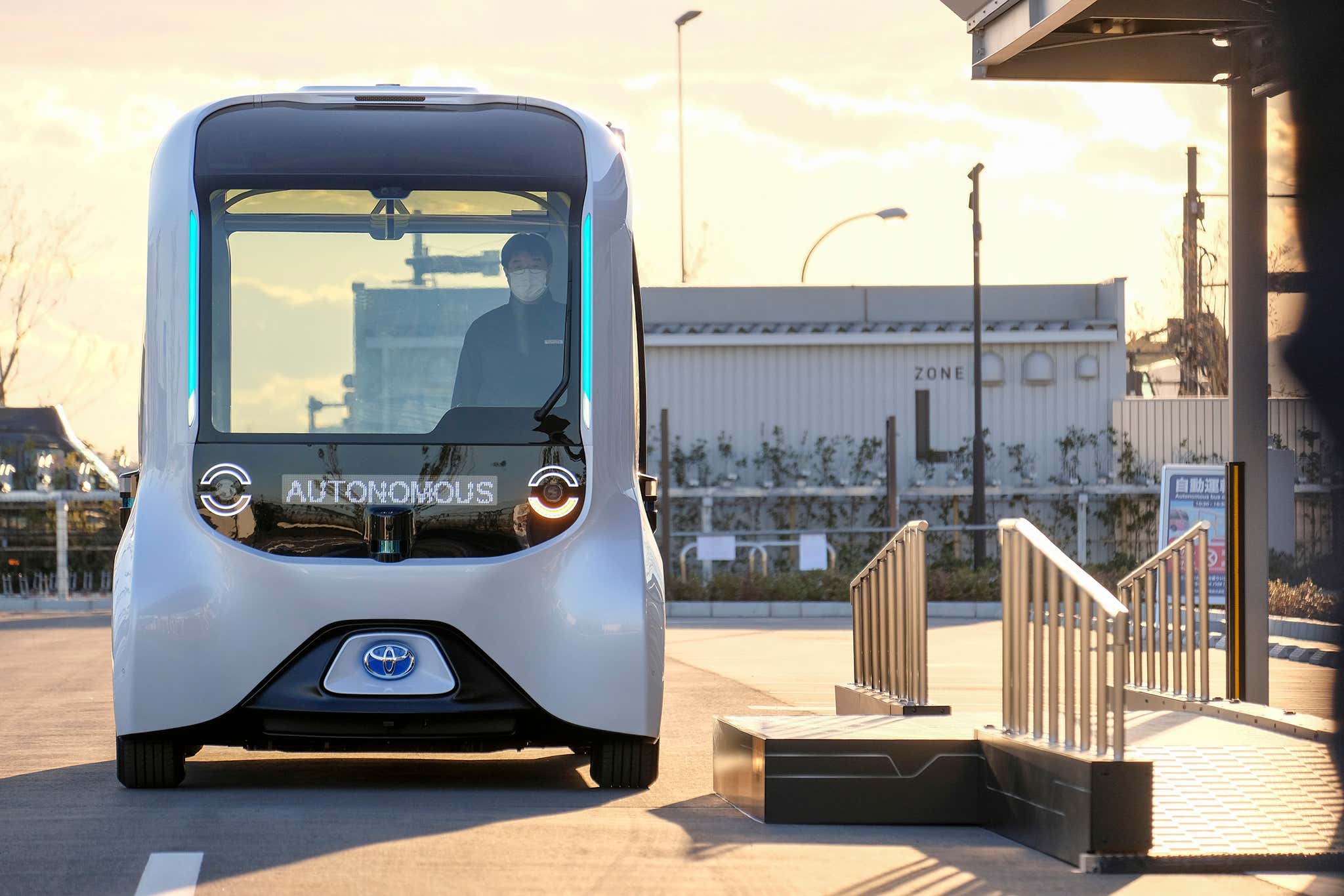
The Toyota e-Palette was announced at CES in 2018 and debuted at the 2019 Tokyo Motor Show. For the Olympics, it was used as a loop-line bus service to transport people around the Olympic compound during the games. It runs on fully electric power and has autonomous abilities. A December 2020 press release stated the vehicles allowed for "a single person to manage several vehicles, rather than one person continually monitoring one vehicle, which enables operation with fewer workers," though it appears as though the e-Palette, in this case, was manned by a human. A Toyota spokesperson said that, despite the e-Palette's current suspended operations, "we have not announced that we will be stopping our efforts in future mobility."
Credits:
https://www.thedrive.com/tech/42166/toyota-suspends-all-e-palette-autonomous-service-following-pedestrian-crash
Friday, August 27, 2021
12 Year Old Makes $400,000 Selling NFT Art
"It was a little bit of a fun exercise - but I picked up on really early that they were really receptive to it and they were really good," Imran said. "So then we started getting a little bit more serious - and now it's every single day... but you can't cram this stuff, you can't say I'm going to learn coding in three months." The boys did 20 or 30 minutes of coding exercises a day - including on holiday, he said. Weird Whales is Benyamin's second digital-art collection, following an earlier Minecraft-inspired set that sold less well. This time, he drew inspiration from a well known pixelated whale meme image and a popular digital-art style but used his own program to create the set of 3,350 emoji-type whales. The art world is divided over the current trend for NFTs. Artists say they are a useful additional line of revenue. And there are many stories of eye-wateringly high sales. But there is also scepticism over whether they are a realistic long-term investment.
Credits:
https://www.bbc.com/news/technology-58343062
